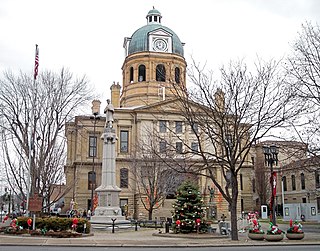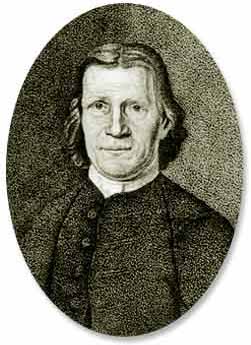
Tuscarawas County is a county located in the northeastern part of the U.S. state of Ohio. As of the 2020 census, the population was 93,263. Its county seat is New Philadelphia. Its name is a Delaware Indian word variously translated as "old town" or "open mouth". Tuscarawas County comprises the New Philadelphia–Dover, OH Micropolitan Statistical Area, which is also included in the Cleveland–Akron–Canton, OH Combined Statistical Area.

The Lenape, also called the Lenni Lenape and Delaware people, are an Indigenous people of the Northeastern Woodlands, who live in the United States and Canada.

The Shawnee are an Indigenous people of the Northeastern Woodlands. Their language, Shawnee, is an Algonquian language.
John Gibson was a veteran of the French and Indian War, Lord Dunmore's War, the American Revolutionary War, Tecumseh's War, and the War of 1812. A delegate to the first Pennsylvania constitutional convention in 1790, and a merchant, he earned a reputation as a frontier leader and had good relations with many Native American in the region. At age sixty he was appointed the Secretary of the Indiana Territory where he was responsible for organising the territorial government. He served twice as acting governor of the territory, including a one-year period during the War of 1812 in which he mobilized and led the territorial militia to relieve besieged Fort Harrison.

Moravian 47 is an Indian reserve located in Chatham-Kent, Ontario, with an area of 13 square kilometres (5.0 sq mi). It is occupied by the Delaware Nation at Moraviantown First Nation, a part of the Christian Munsee branch of the Lenape, and is commonly known as Moravian of the Thames reserve. The resident registered population is 457, with another 587 band members living off the reserve.

The Gnadenhutten massacre, also known as the Moravian massacre, was the killing of 96 pacifist Moravian Christian Indians by U.S. militiamen from Pennsylvania, under the command of David Williamson, on March 8, 1782, at the Moravian missionary village of Gnadenhutten, Ohio Country, during the American Revolutionary War.
Gelelemend (1737–1811) (Lenape), also known as Killbuck or John Killbuck Jr., was an important Delaware (Lenape) chief during the American Revolutionary War. He supported the rebel Americans, known as Patriots. His name signifies "a leader." He was born into the Turtle clan, which had hereditary responsibility for leadership, he became principal chief of the Lenape in November 1778, following the death of White Eyes, a war chief and Speaker of the Delaware Head Council. Gelelemend succeeded his maternal grandfather Netawatwees.

The Delaware languages, also known as the Lenape languages, are Munsee and Unami, two closely related languages of the Eastern Algonquian subgroup of the Algonquian language family. Munsee and Unami were spoken aboriginally by the Lenape people in the vicinity of the modern New York City area in the United States, including western Long Island, Manhattan Island, Staten Island, as well as adjacent areas on the mainland: southeastern New York State, eastern Pennsylvania, New Jersey, Connecticut, Maryland, and Delaware.
White Eyes, named Koquethagechton, was Chief Sachem of the Lenape (Delaware) people in the Ohio Country during the era of the American Revolution. Sometimes known as George White Eyes, or Captain Grey Eyes al. Sir William, his given name in Lenape was rendered in many spelling variations in colonial records.

David Zeisberger was a Moravian clergyman and missionary among the Native American tribes who resided in the Thirteen Colonies. He established communities of Munsee (Lenape) converts to Christianity in the valley of the Muskingum River in Ohio; and for a time, near modern-day Amherstburg, Ontario.

The Christian Munsee are a group of Lenape, an Indigenous people in the United States, that primarily speak Munsee and have converted to Christianity, following the teachings of Moravian missionaries. The Christian Munsee are also known as the Moravian Munsee or the Moravian Indians, the Moravian Christian Indians or, in context, simply the Christian Indians. As the Moravian Church transferred some of their missions to other Christian denominations, such as the Methodists, Christian Munsee today belong to the Moravian Church, Methodist Church, United Church of Canada, among other Christian denominations.
Wakatomika was the name of two 18th century Shawnee villages in what is now the U.S. state of Ohio. The name was also spelled Wapatomica, Waketomika, Waketomica, and Waketameki, among other variations, but the similar name Wapakoneta was a different Shawnee village. Both Wakatomikas were destroyed in raids, the first by colonial Virginians in 1774, the second by Kentuckians in 1786.

The Crawford expedition, also known as the Sandusky expedition and Crawford's Defeat, was a 1782 campaign on the western front of the American Revolutionary War, and one of the final operations of the conflict. The campaign was led by Colonel William Crawford, a former officer in the U.S. Continental Army. Crawford's goal was to destroy enemy Native American towns along the Sandusky River in the Ohio Country, with the hope of ending Native attacks on American settlers. The expedition was one in a series of raids against enemy settlements that both sides had conducted throughout the war.
Custaloga, also known as Packanke, was a chief of the Delaware (Lenape) tribe in the mid-18th century. He was a member of the Wolf Clan through his mother. Captain Pipe was his nephew and succeeded him as chief.
David Williamson (1752–1814) was a mass murderer and colonel in the Pennsylvania Militia during the American Revolutionary War. He was born near Carlisle, Pennsylvania, and led American militiamen in the Gnadenhutten massacre of the Moravian Christian Indian Martyrs, though he failed in his plan to massacre the Christian Indians in Schoenbrunn. He led Pennsylvanian soldiers in the massacre of peaceful Delaware Indians in Killbuck Island and was second in command in the Crawford expedition. David Williamson allowed his men to rape women and children in the cold snow while simultaneously killing them.

McColloch's Leap was a feat performed during a September 1777 attack by Native Americans on Fort Henry, site of present-day Wheeling, West Virginia, during the American Revolutionary War. While escaping a Native American warband, American frontiersman Samuel McColloch rode his horse down a dangerously high and steep drop. Both he and his horse survived without injury. The leap is based on a historic event, but retellings have exaggerated the story into a local legend or tall tale.
Lenape settlements are villages and other sites founded by Lenape people, a Native American tribe from the Northeastern Woodlands. Many of these sites are located in Ohio and Pennsylvania.
Dunquat, known as the Half-King of the Wyandot people, sided with the Kingdom of Great Britain in the American Revolutionary War. He and his people moved to the Ohio country to fight the Americans in the west. He led a mixed band of about 200 Indians at the Siege of Fort Henry (1777). During the war, he protected Christian Delaware people from other members of their tribe prejudiced against their beliefs.
Half King "was particularly attentive to prevent all drunkenness, knowing that bloodshed and murder would immediately follow." He insisted on the removal of the Christian Indians from the vicinity of Sandusky, believing it to be unsafe for them to remain there; he also protected the Moravians and their converts from maltreatment when the missionaries were sent to Detroit ...

Kuskusky, also known as the Kuskuskies Towns, Kuskuskie Towns, or Kuskuskies' Indian Town, with a wide variety of other spellings, were several Native American communities inhabited near New Castle, Mahoning, and Edinburg, Pennsylvania, and Youngstown, Ohio, during the mid-18th century. It was not one town, but three or four contiguous towns of the Mingoes, Lenape, and Seneca, located along the Beaver River, at and above the junction of its east and west branches, the Mahoning River and the Shenango River. It is usually referred to in the plural.

Muskingum was a Wyandot village in southeastern Ohio from 1747 to 1755. It was an important trade center in the early 1750s, until it was devastated by smallpox in the winter of 1752. The town was repopulated for a short time afterwards, then abandoned again as a new community was established by Netawatwees a few miles to the east at Gekelukpechink. The city of Coshocton, Ohio was founded close to the site of the village in 1802.